Valence Electrons and the Octet Rule
Objective: Know the octet rule for bonds.
The objective of this assignment is to visualize how orbital shells of electrons distribute throughout an element. Understanding how electrons are distributed in an element allows us to understand valence electrons which are the building blocks for chemical bonds. These bonds are formed because of the octet rule, which is the desire for an element to have a complete valence shell of 8 electrons. This project will display this objective through the levels of electron shells of a chlorine atom, the valence electrons of a chlorine atom, and finally how a chlorine atom bonds to a hydrogen atom to complete its valence shell and form HCl (Hydrochloric Acid) a strong acid that is used in the stomach to break down foods in the digestive system.
The Atom
Each element is comprised of protons, neutrons, and electrons with the exception of Hydrogen which does not have neutrons. Protons and neutrons are found in the nucleus of the atom while electrons orbit around the nucleus. There have been many models trying to predict how electrons orbit around the nucleus and although not a scientific law, the latest theory is that electrons orbit around the nucleus based on s, p, d and f orbitals. The more electrons the atom has, the more orbital shells are filled up.
There is a specific order for how these orbital are filled and this is shown is the following example.
Figure 1
This picture shows the first two electrons orbiting around the nucleus, filling the 1s orbital.
Figure 2
This shows the 2s orbital being filled with 2 electrons.
Figure 3
This shows the addition of the p block of orbitals shown in blue. The p orbital adds 6 more electrons before becoming filled.
Figure 4
This is the addition of the 3s orbital containing 2 electrons. This is shown by the long sticks attached to the pink pompoms, attached to the top and bottom of the atom.
Figure 5
This shows the complete configuration of electrons for a chlorine atom by adding 5 more atoms into the 3p orbital for a complete number of 17 electrons in a chlorine atom.
Figure 6
This is a slight configuration to show the 7 valence electrons of a chlorine atom. This is done by replacing the 2 electrons of the 3s orbital and 5 electrons of the 3p orbital with red pompoms to indicate that these are valence electrons.
Figure 7
Is the a color key to understanding the electrons of the different orbitals in the chlorine atom.
Figure 8
Shows the Lewis structure of Chlorine, indicating the number and structure of valence electrons in an element. In the case of Chlorine, there are 7 valence electrons.
Figure 9
Shows the valence electrons of the 2 atoms chlorine and hydrogen before they bond together.
Figure 10
Shows the complete valence of hydrogen and chlorine in the covalent bond forming hydrochloric acid (HCl). An interesting note is that the shared electron is closer to the chlorine. This is because the chlorine is more electronegative. Electronegativity can be a complex subject but for the scope of this project we will say that it is the amount of attraction (grabbiness) and atom has for electrons.
How this relates to the octet rule
Each element has a different number of electrons. The configuration of these electrons via orbitals determines their valence electrons. Simply put, valence electrons are just the outer shell of electrons of the s and p orbitals. These valence electrons determine bonding ability because of the octet rule. The octet rule simply states that all electrons are trying to reach a stable state of 8 valence electrons so that their outer shell is complete. Atoms will combine based on their number of valence electrons until they gain a full shell of 8 valence electrons. In our example, chlorine only needs 1 more valence electron to become complete and hydrogen needs to get rid of an electron to become complete (hydrogen is a bit of an exception to the octet rule) so they combine and then both are a complete in valence of electrons . Carbon a common element in biology has 4 valence electrons meaning that it can easily bind to many other elements which is why so many molecules contain carbon. The topic of valence electrons is quite essential in the understanding of the octet rule and how elements bind together to form molecules in the human body.
As you can see, elements are composed of orbitals of electrons. These electrons form the valence electrons which are simply the outer shell of electrons in an atom. This can be 1 valence electron doubling as the only electron as in the case of a hydrogen atom or 7 valence electrons as in case of a chlorine atom. Valence electrons are important because they determine how elements interact and bond because of the octet rule. This is just a simple overview of how electron orbitals form valence electrons that interact to form molecules via the octet rule. This is a brief overview of how the molecules that are used in the human body are formed through electron orbitals valence electrons and the octet rule. Simply put chemistry is essential for biology.
Bibliography:
Chellan, P., Sadler, P. J. (2015). The elements of life and medicines. Philos Trans A Math Phys Eng Sci., 373(2037): 20140182.
Grabowski, S. J. (2020, October). Hydrogen bond and other Lewis acid-Lewis base interactions as preliminary stages of chemical reactions. Molecules Journal. 25(20):4668.
Grabowski, S. J. (2011, February 15). What is the covalency of hydrogen bonding? Chemical Reviews. 111, 4, 2597-2625.
Gilbert, T. R., Kriss, R. V., Foster, N., Bretz, S. L. (2018) Chemistry, An Atoms-Focused Approach. New York, NY. W.W. Norton & Company.






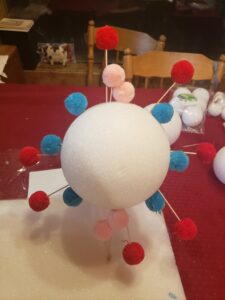
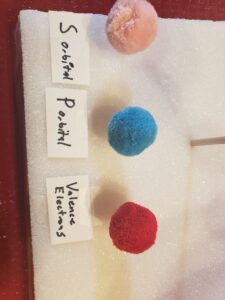
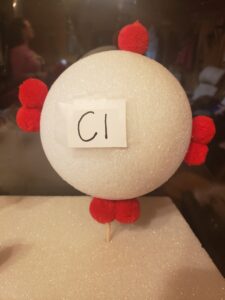
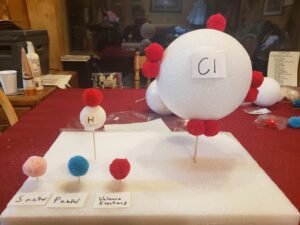
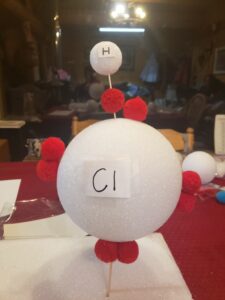
The objective covered by this project is knowing the octet rule for bonds. The models are essentially 3D versions of a Bohr Model. They show the different electron orbitals (1s, 2s, 3s, 2p, 3p…) being filled by electrons. As the electron orbitals fill up, we eventually make it to the outermost shell. This orbital varies between different atoms but always houses the valence electrons. Valence electrons are important because they help to determine what other atoms and how many other atoms a specific atom can bond with. Specifically, we’re interested in the number of valence electrons. The number of valence electrons an atom has determines how many more electrons the atom needs to be satisfied. In this situation, the octet rule applies. The octet rule states that an atom needs eight electrons in its valence shell to be satisfied. The models in this project use an atom of chlorine and an atom of hydrogen to show how this works. It shows the electrons filling up each orbital until we get to the valence electrons. An atom of chlorine has seven valence electrons, meaning it only needs one more to be satisfied. The chlorine atom is satisfied when a hydrogen atom shares its one electron.